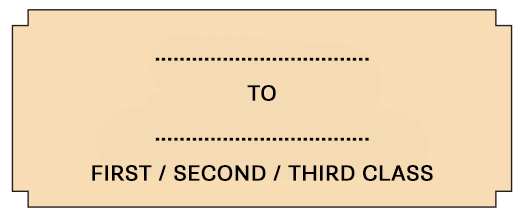Part Three – How shall we get there?
Suggested inquiry questions: What types of transportation were available in the Victorian period?
Potential activities: Look at the Victorian images. Create a steam train using materials and sound effects.
It’s time to choose a method of travel for our trip to the beach. Let’s explore the options available to the Victorians and begin our journey.
The following ‘tasks’ are suggested activities which you can choose from or adapt to make them suitable for your students.
Tasks
Play video three
Choose how to get to the seaside.
‘How shall we get there? By ship? No! By bicycle? No! By balloon? No! By train? Yes!’
A steam train in your classroom
Experience all the sensations of a steam train journey in the classroom. Make some tickets for your students to be punched as they board the train. You’re welcome to use the template below. How will you travel – first, second or third class? It will make a difference to how comfortable your journey is…as well as the cost!
When everyone is on board, choose a guard to wave a flag to signal your departure. Then, you’re off! Move round the classroom in a line of ‘carriages’ towards your seaside destination. Practice stopping and starting at stations on the way. Remember that train travel 130 years ago was noisy and bumpy. If you have any large pieces of light-coloured organza material, use them as the engine’s smoke and waft them over your students. If you go through a tunnel, use some dark material to throw over everyone.
Sound effects
Play the steam engine sound file as you make your journey.
(Warning for loud train whistle at the start of this file and periodically throughout.)
Audio PlayerThings to discuss:
- Look at image one and discuss the different types of transport you can see. How many other types can you name? Which ones would be best for a day trip to the seaside? Why? Why are there no planes or cars in the picture?
- In the Excursion train image, there are porters carrying heavy luggage. Discuss the important things to pack for a trip. What should we always take with us whenever we go out?
Background
Further information:
The world’s first public steam railway was the Stockton and Darlington Railway in County Durham opened in 1825. The next twenty years saw a huge expansion of the railway network in Britain. By 1870, there were 16,000 miles of track being used by 423 million passengers. By 1901, over one billion train journeys were being made.
Before the railways in the 1820s, it took six hours to travel from London to Brighton. By the 1860s, that had been reduced to two hours with the opening of the Brighton-to-London railway line. Express trains could travel up to 80 miles per hour. But some people were worried about the effect these high speeds might have on the human body. Queen Victoria was so frightened by the high speed of her train journey from Slough to London that she demanded the driver go slower than his normal 40 miles per hour.
In the early days of the railways, many rail companies were reluctant to cater for the working classes, only offering first and second-class carriages on their trains. Travelling second or third-class was also very uncomfortable, with wooden benches and open carriages. In fact, early third-class carriages were little more than cattle trucks. In the early days of rail travel, all classes of carriage were unheated and only first-class was lit. The Railway Act of 1844 required all trains to have third class carriages and for all carriages to be enclosed.
Back to top
Suggested inquiry questions: What types of transportation were available in the Victorian period?
Potential activities: Look at the Victorian images. Create a steam train using materials and sound effects.
Part One – Entering the Archives
Going back in time
Part Four – On the beach
Where do we want to sit on the beach? What activities can we do while we’re here?
